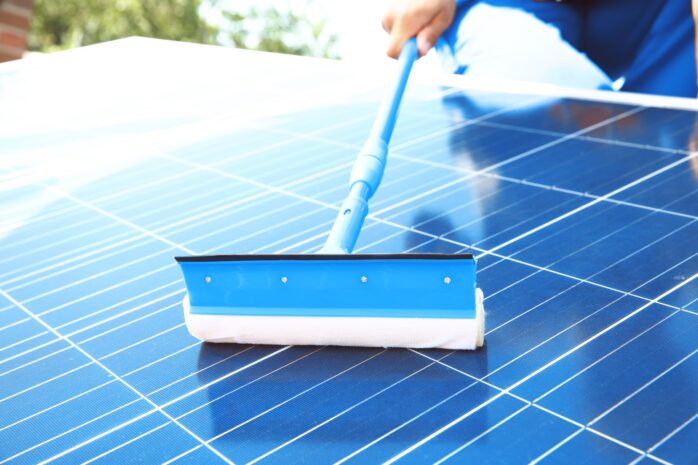In this in-depth exploration, we delve into the often-overlooked aspect of solar energy production: cleanliness. Efficiency is paramount for optimizing energy production, and it turns out that their cleanliness plays a crucial role.
This blog post will unravel the layers behind the seemingly mundane task of cleaning solar panels and its profound impact on energy production. We will look at this through the lens of a case study, making the insights tangible and actionable.
The Significance of Cleanliness

Maintaining cleanliness is not merely about aesthetics; it’s a critical component in maximizing energy efficiency and output. Let’s dive into the mechanics of how dirt accumulation can affect performance and the broader implications for energy production.
Dust, bird droppings, leaves, and other debris can accumulate on the surface forming a layer that obstructs sunlight. This obstruction can significantly reduce the amount of light hitting the solar cells, thus decreasing their efficiency and the amount of electricity generated.
The first paragraph under this heading will illustrate how even a thin layer of dust can lead to noticeable drops in energy output. The second paragraph will provide data from studies that quantify these effects, offering a clearer picture of the direct impact that cleanliness has on efficiency.
The repercussions of decreased efficiency extend beyond the immediate loss in energy production. In the economic context, lower efficiency translates to reduced cost-effectiveness of the solar energy system, affecting the return on investment for businesses and homeowners alike.
The first paragraph will discuss the financial implications of reduced efficiency due to unclean solar panels. In contrast, the second paragraph will explore the environmental consequences, including the potential increase in carbon footprint when cleaning solar panels do not operate at optimal levels.
A Case Study ─ Real-World Implications
To provide a concrete example of the impact of solar panel cleanliness on energy production, we’ll examine a case study from a solar farm that implemented a regular cleaning schedule. This section will shed light on the practical aspects of maintaining cleanliness and the tangible benefits that ensued.
Before and After ─ Analyzing the Data
This case study begins by detailing the condition and performance before the implementation of a regular cleaning routine. The initial data will reveal the extent of efficiency loss due to accumulated dirt and debris.
The following section will present the post-cleaning performance data, showcasing the recovery in efficiency and energy output, and providing a compelling before-and-after comparison that underscores the importance of cleanliness.
Lessons Learned and Best Practices
The final part of the case study will extract valuable lessons from the experience of the solar farm. This will include insights into the most effective cleaning techniques, the optimal frequency of cleaning, and the cost-benefit analysis of different approaches. By sharing these findings, this section aims to provide readers with practical advice and best practices for maintaining their solar panels, ensuring they operate at peak efficiency.
The Role of Technology in Solar Panel Maintenance

As the solar industry continues to evolve, so too does the technology surrounding the maintenance. Innovations in cleaning technology and monitoring systems are paving the way for more efficient and less labor-intensive upkeep. This section explores how these advancements are changing the landscape of panel maintenance.
Recent advancements in cleaning technology, such as automated cleaning robots and water-efficient cleaning systems, are revolutionizing how we approach maintenance. In this paragraph, we’ll discuss the emergence of these technologies, how they work, and their benefits over traditional cleaning methods.
The following paragraph will delve into the effectiveness of these innovative solutions, backed by case studies and research findings, to demonstrate their impact on maintaining optimal efficiency.
The development of sophisticated monitoring systems has greatly enhanced the ability to track performance and condition. This paragraph will introduce the concept of predictive maintenance enabled by these monitoring systems, which can alert owners to potential issues before they lead to significant efficiency losses.
Subsequently, we’ll explore how this proactive approach can extend the lifespan of solar panels and ensure they consistently operate at peak performance, thus maximizing energy output and investment returns.
Global Trends and the Push for Cleaner Solar Energy

As the world moves towards more sustainable energy solutions, cleanliness and efficiency have garnered international attention. This section will examine how different countries are addressing the challenge of maintaining panels and the global trends emerging in the pursuit of cleaner solar energy.
Different regions around the world have begun implementing standards and policies aimed at promoting optimal performance. In this paragraph, we’ll cover the variety of approaches taken by different countries, from mandatory cleaning schedules to incentives for regular maintenance. The following paragraph will discuss the impact of these policies on global solar energy production and how they are influencing practices in other parts of the world.
The Environmental Impact of Cleaning
While cleaning is essential for maintaining efficiency, it’s crucial to consider the environmental impact of the cleaning processes themselves. This section delves into the balance between effective cleaning and environmental sustainability.
The traditional cleaning of solar panels often requires significant amounts of water, posing a challenge in arid regions or places facing water scarcity. This paragraph will discuss the environmental implications of high water usage for cleaning and the importance of adopting water-efficient methods.
Following this, we’ll explore innovative cleaning solutions that minimize water use and their effectiveness in maintaining panel efficiency without exacerbating water scarcity issues.
The choice of cleaning materials also plays a significant role in the environmental footprint of maintenance. This paragraph will examine the impact of chemical cleaners and the push towards using eco-friendly alternatives. The subsequent discussion will highlight the development and adoption of green cleaning methods and materials, assessing their effectiveness and benefits for both performance and the environment.

Conclusion
In wrapping up this exploration, it becomes clear that the simple act of cleaning solar panels can have far-reaching effects on their performance and, by extension, on the broader energy landscape.
This case study not only highlights the importance of regular maintenance but also serves as a call to action for individuals and businesses to adopt practices that will enhance the efficiency and sustainability of solar energy production. Through diligence and proper care, we can all contribute to a greener, more efficient future.




